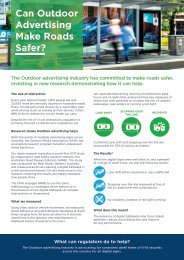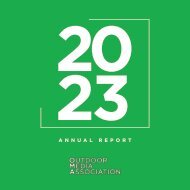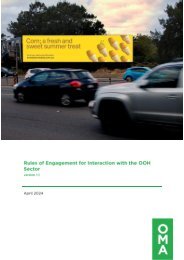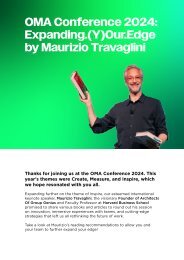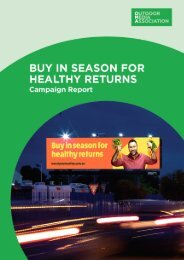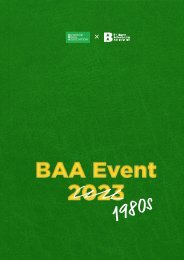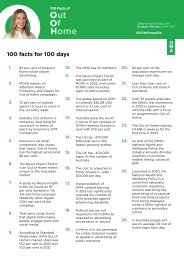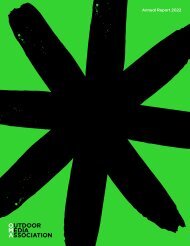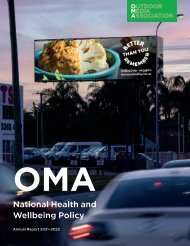OPEN 2
The OPEN series was born from the desire to create a forum for applauding and interrogating strong creative design within the Out of Home (OOH) industry. Illustrating how OOH is part of our cityscape, our commute, our weekend and our shopping and holiday experiences, OOH is ‘the original tweet’ and it cannot be switched off, ignored or fast forwarded. Big, bold, cheeky, simple, clever and controversial, OOH is the ultimate creative stage, allowing brands to be unique, contextually relevant and targeted while reaching mass audiences.
The OPEN series was born from the desire to create a forum for applauding and interrogating strong creative design within the Out of Home (OOH) industry. Illustrating how OOH is part of our cityscape, our commute, our weekend and our shopping and holiday experiences, OOH is ‘the original tweet’ and it cannot be switched off, ignored or fast forwarded. Big, bold, cheeky, simple, clever and controversial, OOH is the ultimate creative stage, allowing brands to be unique, contextually relevant and targeted while reaching mass audiences.
Create successful ePaper yourself
Turn your PDF publications into a flip-book with our unique Google optimized e-Paper software.
TELL ME A STORY<br />
Ben Welsh, Executive Creative Director,<br />
M&C Saatchi<br />
...<br />
OOH!<br />
If I had been asked to do an Out-of-Home ad<br />
I would have written:<br />
‘OUT OF HOME IS WHERE THE HEART IS’<br />
Then I could have got someone to make<br />
it look nice, put my feet up and had a beer. But<br />
for some divine sense of irony, the brief was<br />
800 words on OOH. So here goes.<br />
I was lucky enough to judge Outdoor<br />
at Cannes last year [2013]. It was a remarkable<br />
experience. There were over 5,000 entries and<br />
they covered everything from a set of bathroom<br />
scales with a mirror (don’t ask) to a massive<br />
outdoor construction that captured drinking<br />
water from the air.<br />
The category encompassed pretty much<br />
everything that appeared in the show, from<br />
innovation to good old-fashioned 24-sheet<br />
posters. It varied from daft to inspired, shit<br />
to sublime, but at the end of four days of talking,<br />
the ideas we were considering for the Grand<br />
Prix tended to have one thing in common:<br />
a social purpose.<br />
These advertisements weren’t just<br />
effortlessly communicating something, they<br />
were part of the local community and they were<br />
solving a problem. And in doing so, they told<br />
a cultural story.<br />
Let’s start with Egypt. Apparently loose<br />
change is in short supply, so in the equivalent<br />
of their milk bars you might be given a couple<br />
of carrots in place of a few coins. This turned<br />
out to be a huge opportunity for Vodafone<br />
Prepaid. They circulated recharge strips, called<br />
‘Fakkas,’ of varying small denominations to<br />
these change-strapped milk bars. This use of<br />
possibly the world’s smallest outdoor medium<br />
led to Vodafone becoming the pre-paid network<br />
of choice.<br />
Closer to home (well, Cannes was home<br />
that week) IBM were creating interesting<br />
stories in Paris with more traditional OOH<br />
with Smart ideas for smarter cities (pp. 114–115).<br />
It was also one of those things that could have<br />
been so very dull and corporate, and yet here it<br />
was, not just delivering a message but providing<br />
a useful function. After much discussion, it<br />
ended up winning the Grand Prix. It was so<br />
simple and clear and, if I’m honest, refreshingly<br />
traditional (the mirror on those bathroom<br />
scales had clearly upset everyone).<br />
On the other side of the Atlantic, people<br />
in Brazil were finding an opportunity in<br />
another cultural phenomenon, football. The<br />
state of Bahia, like the rest of the country, had<br />
a problem with blood donations. They also<br />
had a football club called Vitoria who proudly<br />
wore black and red jerseys. To raise awareness<br />
of the need for blood, the team took to the field<br />
in black and white. As donations started to flow,<br />
the red returned to the jerseys, one strip at<br />
a time. My blood is red and black, and pure<br />
genius. It wasn’t a poster, but it had thousands<br />
and thousands of people staring at it for over<br />
90 minutes, four weeks in a row.<br />
On the other side of the Andes, a billboard<br />
in Lima for the local University of Engineering<br />
and Technology had been turned into a water<br />
dispenser (pp. 116–117). Not through plumbing<br />
but through, well, I don’t honestly understand<br />
what. It had something to do with an air filter,<br />
a condenser and a carbon filter. Anyway, the<br />
end result was 96 litres of drinking water a day<br />
served up to the world’s driest city, and a lesson<br />
in why thirsty young Peruvians should choose<br />
University of Engineering and Technology.<br />
Okay, another ocean crossing, this time the<br />
Pacific, which brings us back to Australia, and<br />
work that ended up being the world’s most<br />
awarded ever (I think).<br />
Melbourne Metro Trains’ Dumb ways<br />
to die had won everything at Design and Art<br />
Direction (D&AD) and it was busy doing the<br />
same in Cannes. Everyone knows the work<br />
125 /



